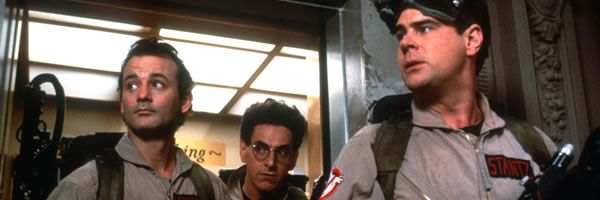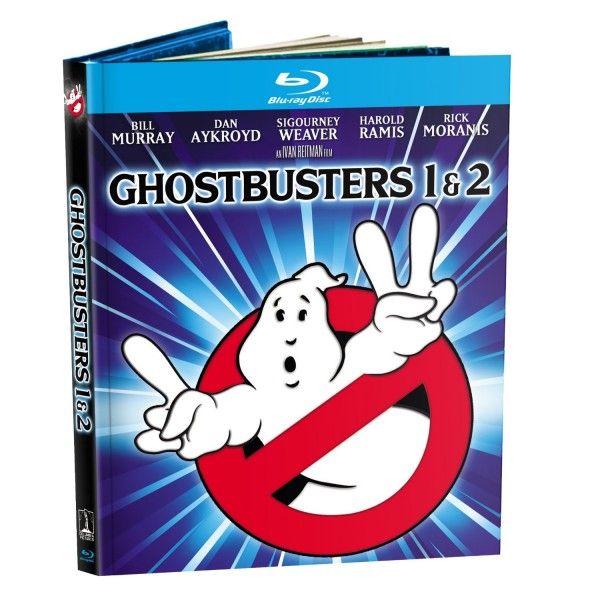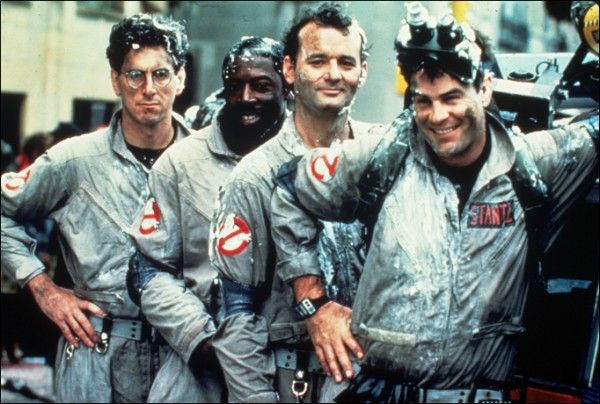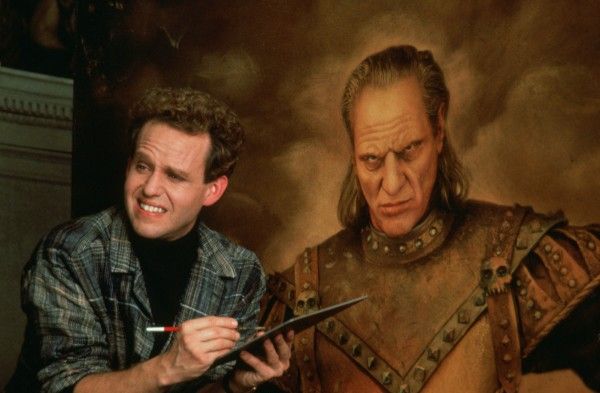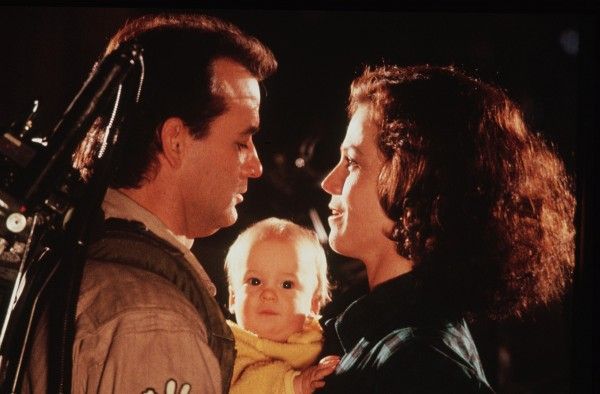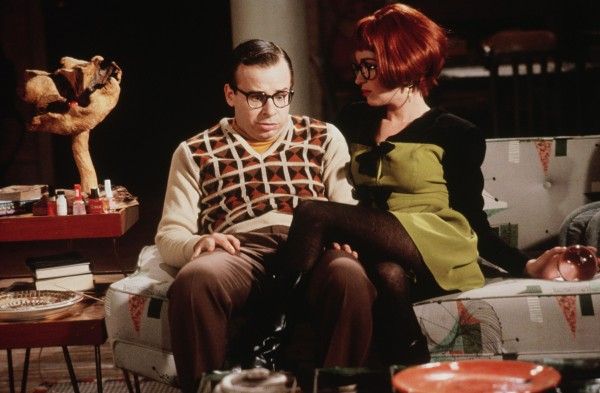Ghostbusters was a cultural phenomenon, and hasn’t left pop culture since it was released in 1984. Then again, it would be hard to forget considering co-writer Dan Aykroyd has been promising a third entry in the franchise since the nineties. To celebrate the thirtieth anniversary of the first film (and the twenty-fifth of the sequel Ghostbusters II) Sony has packaged both together with new extras and the best transfers yet of the films. The first film remains a classic, while the sequel is not without pleasures. Both star Bill Murray, Aykroyd, Harold Ramis, Sigourney Weaver, Ernie Hudson, Rick Moranis, and Annie Potts, and both were directed by Ivan Reitman. My review of Ghostbusters and Ghostbusters II on Blu-ray follows after the jump.
Doctors Peter Venkman (Murray), Raymond Stanz (Aykroyd) and Egon Spengler (Ramis) work at Columbia University together when they’re asked to investigate paranormal activity at a library. There they encounter a free-roaming, vaporous, full torso apparition, and come to realize that they can catch and imprison said ghosts with certain tools. They then return to the university to see that they’ve been fired (mostly, it seems, because of Venkman’s looser research approach), but this leads Venkman to suggest that they should go into business busting ghosts.
They get their first client in Dana Barrett (Weaver), whose refrigerator was possessed by demon dogs that said the word “Zuul.” Venkman is attracted to Barrett, who finds his approach unserious, but he does take the job seriously, maybe. But New York is in the midst of Ghost season, and the three find quite a bit of work, leading to the hiring of Winston Zeddemore (Hudson). Venkman creates a problem for the group when he doesn’t take seriously the questions of EPA toady Walter Peck (William Atherton), while Dana – on the eve of a date with Venkman – is possessed by The Gatekeeper, while her nerdy neighbor Louis Tully (Moranis) is taken over by the spirit Vinz Clortho, also known as The Keymaster (and it delighted me as a teenager to realize the symbolism of their titles). Peck makes good on his threats and shuts down the Ghostbusters, but in doing so unleashes holy hell on New York and it seems the only people who can the world are Venkman, Stanz, Spengler and Zeddemore.
It seems a waste of space to write too much about the first film. It was a massive success in 1984 (it was the biggest hit of that summer, and was only outgrossed by the massive success of Beverly Hills Cop later that year), and plays just as well now as it did when it was released. Everything works in this movie, and repeat viewings often reward with unnoticed small details, especially for those who know the film best through home video, where the image was severely cropped. It’s still just as thrilling as the film builds to its conclusion where the Ghostbusters make a decision to possibly sacrifice their lives to save the world, and just as hilarious to see New York threatened by a Godzilla-sized Stay Puft Marshmallow Man.
The big news with this release (which is available separately as well as packaged with the sequel) is that the third time’s the charm. The first Blu-ray release featured a lacking transfer, though was packed with supplements, while the second release gave the film a 4K remastered transfer, but was issued as a movie-only release in keeping with the studio’s previous Superbit DVDs. Here you not only get the best transfer of the films (the same one on the 4K release), but new supplements along with all of the previously released supplements (many of which go back to the film’s first release of DVD, and some seem copied over from the movie’s Criterion Collection release on laserdisc!)
The film is presented in widescreen (2.35:1) and in DTS-HD 5.1 Master Audio. The film was shot by László Kovács, and it’s always had a gritty New York sheen to it. Image clarity is excellent, and this is likely the best the film can look while still remaining faithful to the original presentation. The surround track is equally good in the sense that it’s been adapted from the original surround tracks. The film can be viewed with a commentary by producer/director Ivan Reitman, co-writer and star Harold Ramis and associate producer Joe Medjuck that’s lively enough, while there’s also the PIP Slimer mode, which collects interview footage from the stars and the behind the scenes people (alas, Bill Murray is not interviewed), and offers factoids when there’s no one talking. New supplements include a gallery of the Gallery 1988 prints to commemorate the film’s 30th anniversary, and a new sit down with Reitman and Aykroyd called “Who You Gonna Call” hosted by Goeff Boecher (24 min.). If you go through the supplements you’re going to hear many anecdotes repeated, but both are game for talking about the film.
Copied over from previous releases is a piece on someone who rebuilt the Ecto-I (16 min.), a still gallery about the car, a featurette on the making of the film from 1984 (10 min.) alongside a making of done for the first DVD release (11 min.), and a talk with the film’s special effects team (15 min.) that was headed up by Richard Edlund. There are also ten deleted scenes in the section “Scene Cemetery” (8 min.) that amount to trims, and alternate takes for the TV-safe version (2 min.). Then there’s a multi-angle exploration of three of the film’s effects sequences (6 min.), that allow you took at footage from the film before the effects were added in, and storyboard comparisons (6 min.) for three sequences. Rounding out the set is the music video for Ghostbusters by Ray Parker Jr. and the film’s theatrical trailer.
When Ghostbusters II rolled around in 1989, it came as part of one of the biggest summers in cinema history to that point. It was a season that featured Indiana Jones and the Last Crusade, Star Trek V, Batman, The Abyss, and Lethal Weapon 2. All were expected to be hits, though some succeeded more than others. Ghostbusters II was highly anticipated, and though the film did well enough (it made over a hundred million domestically), it was not the same sort of blockbuster as its predecessor, nor was it the film of the summer (a title that went to Batman). In fact, it was mostly panned, though some fans champion it as being better than its reputation. I hadn’t watched the film in years because I never felt motivated to watch it again, but after decades away, there are things to like about the film, even if it’s hard not to damn the movie with faint praise.
Five years have passed since the last film, and Dr. Stanz and Zeddemore start the film by performing for children who don’t care anymore. Since the last film the Ghostbusters have been sued out of existence, while Dr. Spengler has moved on to research work, and Dr. Venkman now hosts a TV show about psychics. Dana Barrett has since been married and divorced, and now has an infant, and the the supernatural elements return when the baby’s carriage is possessed and runs into traffic. She goes to Egon and Ray for help, but eventually Peter finds out due to coincidence and tags along. The three find the source of the problem: a river of evil purple slime tunneling under New York City. But in finding it they had to drill into the sidewalk, and in getting out of the hole Ray knocks off the power for the city, which sends them to court. Louis is their lawyer, a job he does horribly, but the “mood slime” Ray got a sample of bubbles over when the judge (Harris Yulin) delivers his sentence, which sets loose two ghosts that have to be stopped.
That’s enough to put the Ghostbusters back in business, and they find a lot work fairly quickly after this (as a montage suggests). All the while Dana, who was in an Orchestra but now cleans old paintings at a museum, is near a portrait of Vigo the Carpathian, who is able to possess Dana’s boss Dr. Janosz Poha (Peter MacNichol), and who wants a baby to deposit his soul into to take over the world.
There’s nothing more irritating than a sequel that starts by undercutting the heroic awesomeness of the last film, so it’s fair to say Ghostbusters II starts off on the wrong foot by wasting thirty five minutes making the Ghostbusters Ghostbusters again. It also has characters change professions simply to keep them in the movie, so it’s impossible to ignore these problems, which come across as laziness. That noted, there is still charming interplay between the performers, which is to be expected: You’re talking about people like Bill Murray and Harold Ramis, etc. You like these actors and their characters, but so much of their material feels like variations on material from the first film. Sometimes it works well (they do another low rent commercial that’s funny), but when it comes to the conclusion it feels like desperation of “how do we do the Stay Puft Marshmallow gag again?” And boy, does that last section just stink on ice. Watching the trailer for this, you get the sense that the film was built on the idea of having slightly different versions of jokes from the first film.
Bill Murray seems a little uninterested in being there, though perhaps it’s just that he can only do so much with the material. The film also doesn’t do well by Ernie Hudson’s character, who is often treated like an afterthought. Where the film works is in the scenes between Annie Potts as the secretary Janine Melnitz and Rick Moranis’ Louis Tully. Potts gets a complete makeover, and here she’s a sexy Velma type, and after being repeatedly turned down by Egon in the last film, she now targets Louis. The two make a great couple, and they have some of the best moments of the film.
It’s also worth noting that director Ivan Reitman is giving this film his all. In the first film, perhaps due to not knowing if the special effects would work on not, he had a very limited visual palette a meat and potatoes approach, whereas in the second film he stages things with much more confidence and visual flair, and the supernatural and gothic elements are a touch scarier. It’s also worth noting that Reitman, between these films and Dave, has been one of Sigourney Weaver’s best directors. Not only that, he knows how to make Weaver look gorgeous. Ultimately, it may be worth buying the two film set if you treat the second film like a bonus feature. It’s not good on its own, and it’s not a very good sequel, but there is enough goodwill from the first film, and enough charming moment and things to make it worth revisiting once every blue moon (or decade).
Ghostbusters II is presented in widescreen (2.35:1) and in DTS-HD 5.1 Master Audio. The transfer is cleaner than the first film, and it’s well served by the new 4K master, it’s a positive gorgeous rendering. The supplements are lighter on this one, with a retrospective look at the film the main supplement. It’s “Time is But a Window: Ghostbusters II and Beyond” and here Geoff Boecher returns to talk with Reitman and Aykroyd about the movie and possible sequels (16 min.). Reitman is a little defensive about the film while acknowledging it may not be the greatest, while Aykroyd seems to think it’s almost as good as the first film. Here they also talk here about possible follow ups (Aykroyd has written many drafts of the third installment). Also included are seven deleted scenes in the “Scene Cemetery” (7 min.), which are mostly jokes that didn’t make the cut or variations on scenes already in the film (like a different fate for Kurt Fuller’s character). Also included is the music video for Bobby Brown’s “On Our Own,” one teaser and two theatrical trailers.

